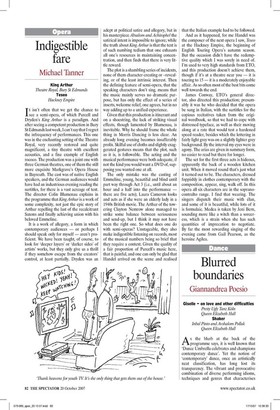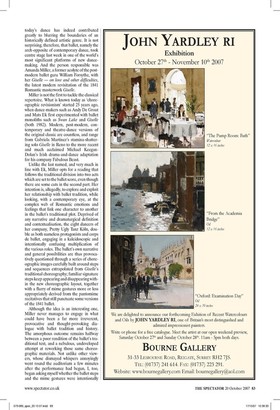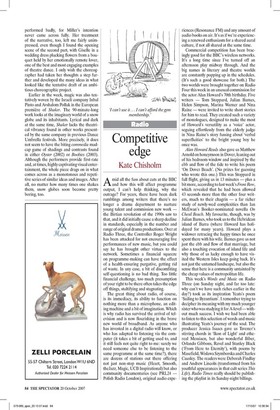Blurred boundaries
Giannandrea Poesio Giselle – on love and other difficulties Pretty Ugly Tanz Köln Queen Elizabeth Hall Shaker Inbal Pinto and Avshalom Pollak Queen Elizabeth Hall s the blurb at the back of the programme says, it is well known that 'Dance Umbrella celebrates and champions contemporary dance'. Yet the notion of 'contemporary' dance, once an artistically neat classification, has long lost its transparency. The vibrant and provocative combination of diverse performing idioms, techniques and genres that characterises today's dance has indeed contributed greatly to blurring the boundaries of an historically defined artistic genre. It is not surprising, therefore, that ballet, namely the arch-opposite of contemporary dance, took centre stage last week in one of the world's most significant platforms of new dancemaking. And the person responsible was Amanda Miller, a former acolyte of the postmodern ballet guru William Forsythe, with her Giselle — on love and other difficulties, the latest modern revisitation of the 1841 Romantic masterwork Giselle.
Miller is not the first to tackle the classical repertoire. What is known today as 'choreographic revisionism' started 25 years ago, when dance-makers such as Andy De Groat and Mats Ek first experimented with ballet monoliths such as Swan Lake and Giselle (both 1982). Modern, post-modern, contemporary and theatre-dance versions of the original classic are countless, and range from Gabriela Martinez's stamina-shattering solo Giselle in Reno to the more recent and much acclaimed Michael KeeganDolan's Irish drama-and-dance adaptation for his company Fabulous Beast.
Unlike the last named, and very much in line with Ek, Miller opts for a reading that follows the traditional division into two acts which are set to the ballet score, even though there are some cuts in the second part. Her intention is, allegedly, to explore and exploit her relationship with ballet tradition, while looking, with a contemporary eye, at the complex web of Romantic emotions and feelings that link one character to another in the ballet's traditional plot. Deprived of any narrative and dramaturgical definition and contextualisation, the eight dancers of her company, Pretty Ugly Tanz Köln, double as both nameless protagonists and corps de ballet, engaging in a kaleidoscopic and intentionally confusing multiplication of the various roles. The ballet's own narrative and general possibilities are thus provocatively questioned through a series of choreographic images carefully built around steps and sequences extrapolated from Giselle's traditional choreography; familiar signature steps keep appearing and disappearing within the new choreographic layout, together with a flurry of mime gestures more or less appropriately derived from the pantomime recitatives that still punctuate some versions of the 1841 ballet.
Although the idea is an interesting one, Miller never manages to engage in what could have been a far more irreverent, provocative and thought-provoking dialogue with ballet tradition and history. The amorphous outcome remains halfway between a poor rendition of the ballet's traditional text, and a nebulous, undeveloped attempt at reworking those same choreographic materials. Not unlike other viewers, whose dismayed whispers annoyingly went round the auditorium a few minutes after the performance had begun, I, too, began asking myself whether the ballet steps and the mime gestures were intentionally performed badly, for Miller's intention never came across fully. Her treatment of the narrative, too, left me fairly unimpressed, even though I found the opening scene of the second part, with Giselle in a wedding dress plucking flowers from a bouquet held by her emotionally remote lover, one of the best and most engaging examples of theatre dance. I only wish the choreographer had taken her thoughts a step further and developed the many ideas in what looked like the tentative draft of an ambitious choreographic project.
Earlier in the week, magic was also tentatively woven by the Israeli company Inbal Pinto and Avshalom Pollak in the European premiere of Shaker. The 90-minute-long work looks at the imaginary world of a snow globe and its inhabitants. Lyrical and dark at the same time, Shaker lacks the theatrical vibrancy found in other works presented by the same company in previous Dance Umbrella festivals. More precisely, it does not seem to have the biting commedia madcap game of shadings and contrasts found in either Oyster (2002) or Boobies (2003). Although the performers provide first-rate and, at times, highly captivating visual entertainment, the whole piece drags on in what comes across as a monotonous and repetitive series of similar ideas and images. After all, no matter how many times one shakes them, snow globes soon become pretty boring, too.









































































 Previous page
Previous page